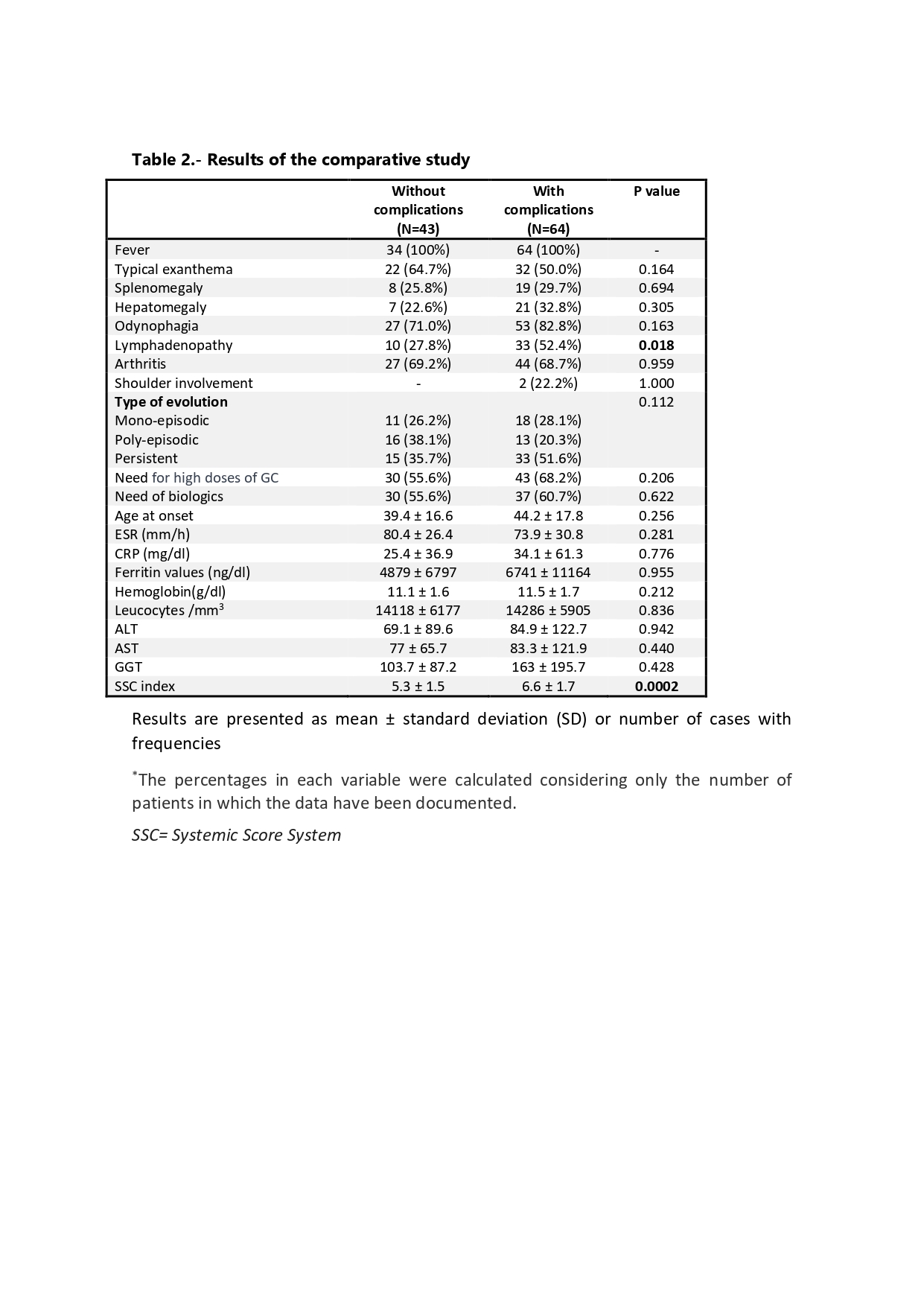Session Information
Session Type: Poster Session B
Session Time: 10:30AM-12:30PM
Background/Purpose: Adult-onset Still’s disease (AOSD) is a rare systemic disorder characterized typically by fever, arthritis, skin rash, leukocytosis, and hyperferritinemia, which are the hallmarks of the disease. Other common manifestations include odynophagia, myalgias, hepatic involvement, lymphadenopathy, and splenomegaly. However, the clinical picture may be complicated by the occurrence of atypical or non-classical complications, which can be severe and potentially life-threatening. Our objective was to investigate the prevalence and clinical spectrum of complications in AOSD beyond macrophage activation syndrome (MAS), and to identify factors linked to their occurrence.
Methods: A retrospective, longitudinal, multicenter study enrolled patients diagnosed with AOSD using the Yamaguchi diagnostic criteria. All participants had undergone at least one year of follow-up.
Results: The cohort included 107 patients (67% women) from 14 centers across various autonomous communities in Spain. Table 1 summarizes their general characteristics and main clinical and laboratory data. Among them, 64 (59.8%) patients had one or more of the following complications, retrospectively recorded in the electronic Data Collection Form:
– MAS occurred in 10 of 105 patients (Prevalence: 9.5%, 95% CI 4.2 to 14.3).
– Atypical skin manifestations were observed in 38 of 98 patients (38.8%, 95% CI 27.4 to 53.2). The most common lesions included persistent pruritic papules and plaques with a linear configuration resembling flagellate erythema, and urticaria-like eruptions.
– Cardiac involvement was noted in 22 of 97 patients (22.7%, 95% CI 14.2 to 34.3), including 18 cases of pericardial disease, four cases of myocarditis, six cases of suspected pulmonary arterial hypertension (PAH) identified by echocardiogram, and one case of inflammatory valvular involvement.
– Pleural disease was present in 28 out of 97 patients and transient pulmonary infiltrates in 4 out of 100 patients, with prevalences of 28.9% (95% CI 19.2 to 41.7) and 4% (95% CI 1.1 to 10.2), respectively.
– Secondary amyloidosis was found in 1 out of 104 patients (0.96%, 95% CI 0.2 to 5.3).
– Significant headaches, serving as a presenting symptom, occurred in 13 out of 92 patients (14.1%, 95% CI 7.5 to 24.2), with some cases objectively confirmed as aseptic meningitis.
– Peritonitis, confirmed by peritoneal effusion on imaging, was observed in 9 out of 107 patients (8.4%, 95% CI 3.8 to 16 ). In the comparative study (Table 2), patients with complications exhibited a higher incidence of lymphadenopathy (52.4% vs. 27.8%; p=0.018) and, as expected, higher values in the Systemic Score System index (6.6 vs. 5.3; p=0.0002).
Conclusion: In addition to typical clinical manifestations and MAS, a significant proportion of patients with AOSD develop uncommon or exceptional complications. These should be considered in the evaluation and follow-up of patients, particularly those with chronic or persistent disease progression. Early recognition and prompt management are crucial to significantly reducing morbidity and mortality
To cite this abstract in AMA style:
Narvaez-García J, García de Yebenes M, Holgado S, Olive A, Casafont-Sole I, Castañeda S, Valero C, Martín López M, Carreira P, Mora Limiñana M, Nuño L, Robles Marhuenda A, Bernabéu P, Campos Esteban J, Graña G, Ortiz V, Camacho M, Vargas C, Sanchez-Manubens J, Anton J. Non-Classical Complications of Adult-Onset Still’s Disease: A Multicenter Spanish Study [abstract]. Arthritis Rheumatol. 2024; 76 (suppl 9). https://acrabstracts.org/abstract/non-classical-complications-of-adult-onset-stills-disease-a-multicenter-spanish-study/. Accessed .« Back to ACR Convergence 2024
ACR Meeting Abstracts - https://acrabstracts.org/abstract/non-classical-complications-of-adult-onset-stills-disease-a-multicenter-spanish-study/


